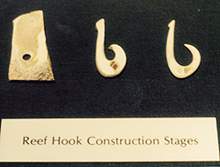|
These relationships are celebrated in sacred songs about the ocean, the totems and the ancestors. The songs emphasise how the two moieties are connected to each other and to the water, and who owns the water. They name their children from songs given to them by Barama and Djan'kawu. This is the law according to the Yolngu people of the salt water ocean.
Art
In all societies, art has been used to express ideas about the origin and purpose of life, the environment and religion. Throughout Oceania, art has been influenced by man's association with the sea. For example, in the Solomon Islands, fish, seabirds, dolphins, sharks or bonito are often depicted on canoes, initiation platforms, canoe-storage houses, meeting places, weapons, dance staffs, fishing floats, bowls, personal ornaments and in body painting. The transition from boy to man has traditionally involved Bonito-fishing, thus Bonito-fishing was often portrayed in art.
|
Marine animals of dietary importance were often recorded in Aboriginal rock art, such as fish, sharks, crocodiles and turtles in north Australia; turtles, large whale-like sea creatures, stingrays and fish near Port Hedland in Western Australia. There are over 60 rock carvings sites in the Sydney area featuring whales and dolphins. Although whales were not hunted by Aboriginal people, stranded whales were an opportunistic source of food and medicine.
At Moreton Bay (Gold Coast, QLD) people used dolphins to catch shoals of mullet. Once the school was sighted, several men would hit the water with their spears to attract the dolphins. The dolphins then chased the mullet towards the shore. Once the mullet entered the shallows, they were easily speared. The dolphins were rewarded for their efforts, i.e., fish were offered to the dolphins from the end of the fisherman's spear. The traditional people of the Gold Coast are the Kombumerri and their totem is the dolphin. |
 |
Apart from marine animals, the ocean itself is also depicted in art. In Arnhem Land, various sacred cross-hatched designs are used in bark paintings to represent saltwater. The artwork from these areas illustrates an intimate knowledge of fresh and salt water. For example, some paintings show the connection between land, sea and sky; and the cycle of fresh water mixing with saltwater through the actions of currents and tides. Others show different sea states (e.g., change from calm, flat water to dangerous, rough water); certain seasons (e.g., choppy seas with white-capped waves showing a particular season when tern eggs are to be collected); and features on the sea floor of sacred significance (e.g., submerged rocks).
Jewellery
Pierced shell and tooth necklaces, bracelets, pendants, and shell breastplates form part of a wide Pacific tradition which may be derived from ancient Lapita. Certain items were important symbols of rank, e.g., leaders in Hawaii and Fiji wore whale tooth ornaments.
Material derived from the ocean is still worn for personal adornment today, notably South Sea pearls, black and pink coral, mother of pearl shell and various species of small shells.
Next .. Exploitation of marine resources
|